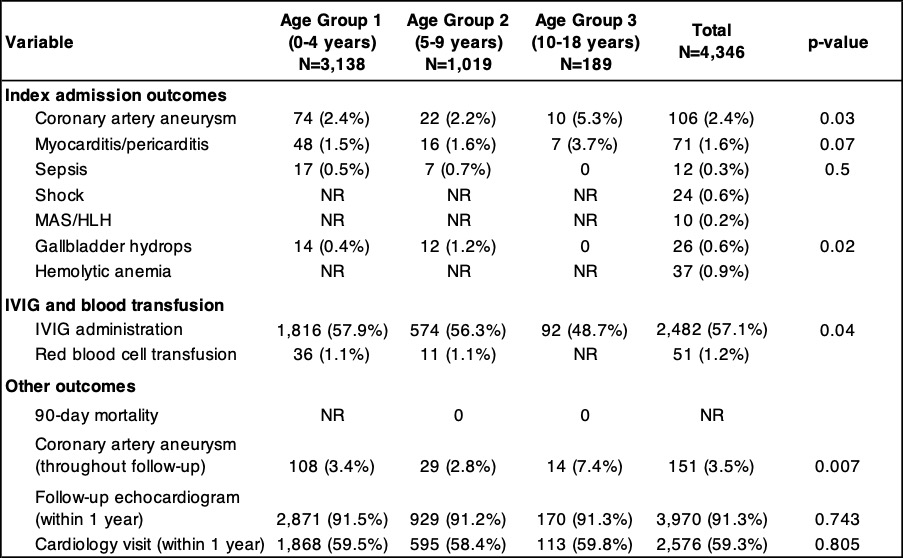Session Information
The 2020 Pediatric Rheumatology Symposium, originally scheduled for April 29 – May 2, was postponed due to COVID-19; therefore, abstracts were not presented as scheduled.
Date: Thursday, April 30, 2020
Title: Poster Session 1
Session Type: ACR Abstract Session
Session Time: 6:00PM-7:00PM
Background/Purpose: Kawasaki disease (KD) is a childhood vasculitis with rising global incidence and the most common cause of childhood acquired heart disease in the developed world. However, over the past two decades, data on the incidence, patient and disease characteristics for KD among North American children are conflicting. These data are critical for informing healthcare resource planning. The objectives of this study were to: 1) Determine KD incidence between 1995 to 2017 among children in Ontario; 2) Compare characteristics among KD children by era (1995-2001 and 2002-2017) and age group (0-4yr, 5-9yr, 10-18yr); and 3) Determine rates of acute complications and follow-up patterns after discharge.
Methods: We used population-based health administrative data to identify all children (0-18 years) hospitalized and diagnosed with KD in Ontario, Canada between 1995 and 2017. Children with a previous diagnosis of KD were excluded. We determined the annual incidence of KD and assessed trends over time using the Cochran-Armitage test.
Results: We identified 4,346 children diagnosed with KD over 22 years. Median age was 3 years (IQR 1-5) and male-to-female ratio was 1.5. KD incidence was 22.0 cases (0-4yr), 6.1 cases (5-9yr) and 0.6 (10-18yr) per 100,000 person-years. KD incidence increased significantly for all age groups (18.4 to 25.0 for 0-4yr, 4.0 to 7.7 for 5-9yr and 0.7 to 1.1 for 10-18yr; p< 0.001), and for males and females during the study (7.5 to 11.1 for males, p=0.001 and 4.6 to 6.5 for females, p< 0.0001). Ninety-day mortality was ≤ 0.1%. Coronary artery aneurysms (CAA) occurred in 106 children (2.4%) during admission and 151 (3.5%) over 11-year median follow-up. CAA frequency did not change significantly over time (p=0.07). Compared to the 0-4yr group, older children (10-18yr) had longer hospital stay (4.3 vs 3.5 days, p=0.003), more PICU admissions (5.3% vs 2.1%, p=0.01) and greater frequency of CAA (7.4% vs. 3.4%, p=0.007). 3,970 (91.3%) and 2,576 (59.3%) children had echocardiogram testing and cardiology follow-up, respectively, by 1 year.
Conclusion: The incidence of KD has increased significantly over the past two decades in Ontario, Canada. Children 10-18 years had worse short-term outcomes, highlighting the importance of early diagnosis and treatment. Future research will evaluate the healthcare resource implications of the rising incidence of KD in order to better plan for the provision of high-quality healthcare to these patients.
To cite this abstract in AMA style:
Robinson C, Chanchlani R, Schlorff M, Lao F, Mondal T, Demers C, Darling E, Brar S, Parekh R, Seow H, Benchimol E, Batthish M. Kawasaki Disease in Ontario Children from 1995-2017: A Population-based Descriptive Analysis [abstract]. Arthritis Rheumatol. 2020; 72 (suppl 4). https://acrabstracts.org/abstract/kawasaki-disease-in-ontario-children-from-1995-2017-a-population-based-descriptive-analysis/. Accessed .« Back to 2020 Pediatric Rheumatology Symposium
ACR Meeting Abstracts - https://acrabstracts.org/abstract/kawasaki-disease-in-ontario-children-from-1995-2017-a-population-based-descriptive-analysis/



